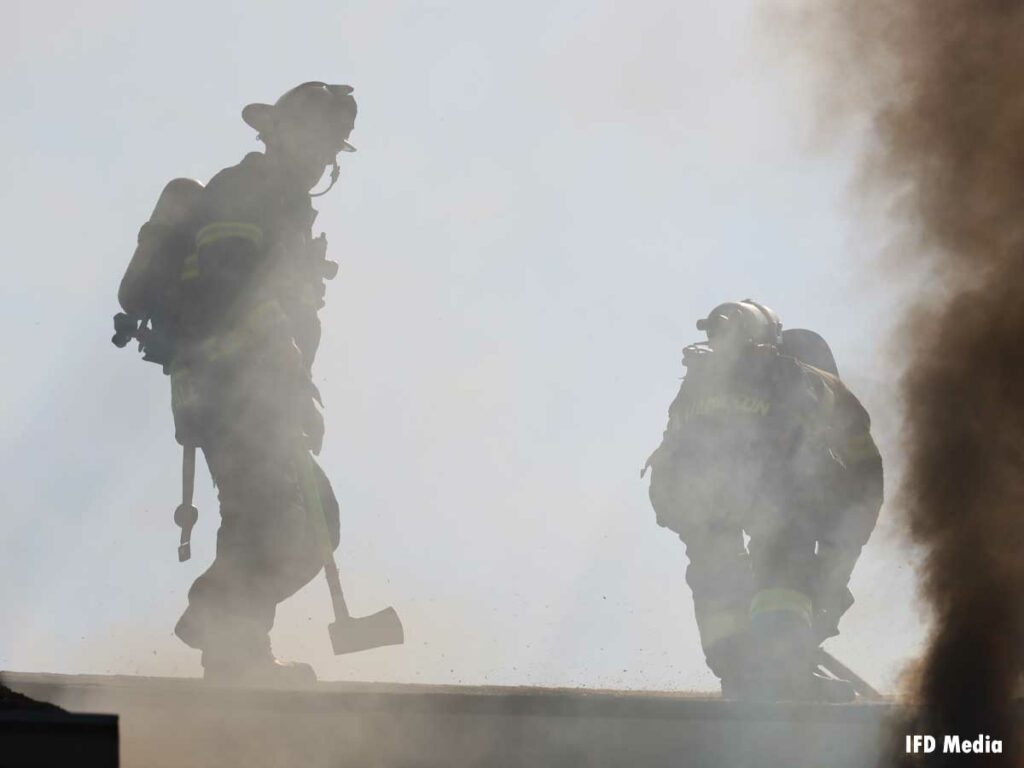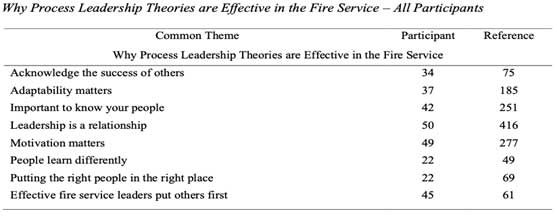
Part 1
By Shelley Wheeler and Frank Ricci
Leadership is about achieving positive change by communicating a vision and a shared purpose. To be an effective leader, your behaviors, traits, and tactics must be consistent and fall within the ideal organizational culture of your fire department or agency. This must be based on organizational values and standards and exhibited through behaviors that exert influence, which will positively impact the relationship between the leader and follower. Leaders must strive to inspire while defining the why and by exhibiting command presence of calmness, confidence, and competence. Successful leaders motivate, mentor, and invoke emulation by leading by example.
- Diminishing Your Own Command, Part 1 | Part 2 | Part 3
- Frank Ricci: Command Presence: Increase Your Influence
- Command Presence: What Is It, and How Do You Develop It?
You need to take care of your people and effectively listen, allowing for two-way communication and cogent debate where ideas can be interrogated during the calm— so you don’t have to explain in the storm.
Leadership theory is ever-growing; the research is not settled or sectional and can transcend any industry—however, many texts advocate for one theory or style. Worse yet, some leaders stop the education process and adopt one style or theory without fully understanding the theory’s complexities or how the nuances affect the operational realities of the organization. It is a misnomer to believe that if you could achieve excellence in the application of one theory, then your success would be predetermined. Every theory and style comes down to a myriad of factors, including but not limited to individual characteristics, morals, politics, outside influences, and behaviors. Regardless of these factors, whether using a single theory or moving between theories requires practice and self-evaluation.
Breaking down leadership can seem daunting and easy to dismiss as an academic exercise, given that we are confronted with more than 60 leadership theories based on years of research aided by a century of the free-market business success and failures combined with the field of war with 10,000 years of strategic analysis of battles and warfare. Make no mistake: it is imperative to achieve continual improvement and build trust by endeavoring to balance training, education, coaching, mentoring, and experience in a building-block approach from the beginning to the end of your career. If your first leadership book or class is taken after a promotion, you are already failing and setting yourself up to play a game of catch up that you may never win.
Although many traditions and cultural similarities exist in the U.S. fire service, the various types (e.g. volunteer, career, local municipalities, federal), size, and geographical location of departments yield unique differences in each organization. Culture can be thought of as a form of unidentified leadership that directs people to relinquish their selves to become part of something greater; in the fire service, that means commitment to the team and the organization1. Therefore, as a service, we should not settle for a particular leadership style. Instead, individual departments must define and communicate the appropriate leadership behaviors that align with their organizational culture. In doing so, upper management within each fire department must recognize the unique underpinnings of its organizational culture and align leadership development with the desired behaviors of the organization. It is important to understand that subcultures exist within larger cultures, and while subcultures may share some values of the broader culture, they also have different values and beliefs on what is acceptable behavior 2. Those entering an organization must understand and accept the values of the specific organization or department. Failing to communicate organizational cultural values such as leadership expectations and ensuring that employees understand and support such values may result in subcultures that refuse to align with organizational values, hindering the goals and objectives of an organization, and creating unwanted outcomes. Defining and communicating leadership styles and implementing training programs that integrate cultural values and expectations are crucial to developing effective leaders across the fire service.
We Have to Talk About It
Unfortunately, there is often a lack of dialogue amongst departmental management about what leadership uniquely means in their culture in terms of values and actions 3. Therefore, there is a need for clear communication regarding what leadership looks like for an organization and how to implement leadership training programs that develop appropriate leader behavior and actions that enhance collaboration and teamwork, resulting in effective leadership across the organization. Developing successful leaders starts with effective communication of internal cultural values and the willingness of fire department personnel to embrace and demonstrate the values of the department, which is why training must start in recruit school and continue throughout one’s career. The vast number of theories and ongoing research regarding leadership make leadership development a continuous process requiring ongoing training throughout a firefighter’s career, regardless of rank or time in service. Leadership development requires training on a wide variety of topics and concepts and will never be successful with a one-and-done training approach.
We Have to Understand It
Leadership theories that align with organizational values offer a way to choose certain traits that organizational managers expect from their leaders and a foundation for continuous leadership development. Although it could prove counterproductive to try to implement leadership practices that only focus on a particular theory, the ideas within certain theories can provide an initial framework for effective leader behaviors in the fire service. For years, fire officer classes outlined by National Fire Protection Association (NFPA) 1021, Standard for Fire Officer Professional Qualifications, focused on explaining leadership via autocratic, democratic, and laissez-faire styles. These three concepts offer little guidance on behaviors or skills that enhance a leader’s abilities. Instead, many modern leadership theories offer behaviors and skills for effective leadership outcomes and are a better consideration when developing a foundational approach toward effective leadership in the fire service. However, individual departments must always consider the behaviors and actions that will best fit their departmental cultures. Transformational, servant, and situational leadership styles are continuously being touted as great models for fire service leadership, but before we get into leadership styles that can help build the fundamentals of leadership culture in an organization, let’s break leadership down to its simplest form, a relationship between a leader and follower. As President Lincoln said: “A leader without followers is just taking a walk.”
Leadership Is a Relationship
Part of the goal of my leadership study (Shelley Wheeler) conducted for my dissertation work was to investigate if fire service personnel from four different departmental cultures embraced the idea of leadership as a relationship and if the transformational, servant, and situational styles of leadership were viable models to build a foundation for leadership in the fire service. The study included 50 participants, 23 career firefighters, and 27 career officers of different ranks and experience levels from four large Metro D.C.- area fire departments. The result of the study aligned with many others researchers’ suggestions that effective leadership relies on building a relationship between the leader and follower. Simply put, leadership is a relationship between those who lead and those who choose to follow, and this cannot exist without mutual respect and confidence, built on a foundation of trust 4. Trust is a paramount tenet of cultural values as it helps build constructive relationships of mutual pride and loyalty, which are vital for group cohesion and organizational success 5. The previous assertions help explain why leadership studies are moving toward process theories and practices that build relationships based on mutual respect and trust.
I (Frank Ricci) have found that building relationships and trust should not be conflated with being popular or leading by consensus. This is a trap where the leader abrogates their authority at the expenses of organizational goals and values, leading to a lack of consistent vision. As a leader, you want to be able to use your influence based off positive behaviors and be able to build consensus around your vision or the vison of your superiors that align with the organization’s goals and values. As Henry Ford said: “If I asked people what they wanted, they would have said faster horses.”
The results of my (Shelly Wheeler) study provided much support that effective leadership is easier achieved when there is a trusting relationship between a leader and follower. In fact, 100% of the participants shared stories about the importance of building relationships to help foster effective leadership. Of course, the sample was only 50 people, and they were from a common area. However, 50 people with differing years of experience and from four different departmental cultures in 100% of agreement start to make a strong case for developing leaders with strong relationship skills. Therefore, if we start with the premise that leadership is a relationship that must exist even in the most hierarchal types of organizations, we can build a leadership culture with basic foundational styles of leadership that help build relationships through mutual respect and understanding (Fig 1). Some process styles are transformational, servant, and situational leadership. See chart below:

All 50 participants identified at least two characteristics of effective leaders that aligned with transformational, servant, and situational leadership styles. See chart below.

In part 2 we will review process-style theories that support the idea of leadership as a relationship.
Dr. Shelley Wheeler is a captain and the training coordinator for Montgomery County (MD) Fire and Rescue Service, as well as a USAR member of MDTF-1. Her degrees include a bachelor’s degree in homeland security and emergency management, a master of business administration with a specialty in organizational leadership, and a doctorate in business administration with a specialty in leadership. Prior to the fire service, she served in the U.S. Coast Guard where she performed search and rescue, law enforcement, and aids to navigation missions as a certified boat coxswain.
Frank Ricci is the author of the book Command Presence, which breaks down behaviors into tangible takeaways and tactics to increase your influence.
REFERENCES
1 Dwairy, M. (2019). Culture and leadership: personal and alternating values within inconsistent cultures. International Journal of Leadership in Education, 22(4), 510–518. https://doi.org/10.1080/13603124.2017.1394498
2 Farrell, M. (2018). Leadership reflections: Organizational culture. Journal of Library Administration, 58(8), 861–872. https://doi.org/10.1080/01930826.2018.1516949
3 Snyder, K., Ingelsson, P., & Bäckström, I. (2018). Using design thinking to support value-based leadership for sustainable quality development. Business Process Management Journal, 24(6), 1289–1301. https://doi.org/10.1108/BPMJ-02-2018-0045
4 Kouzes, J. M., & Posner, B. (2012). The leadership challenge: How to make extraordinary things happen in organizations (5th ed.). Jossey-Bass.
5 Gen, B. S. (2019). Making of competent leaders: Organizations must embrace a culture of learning to empower leaders with relevant skills and ingrain in them strong values. Business Today. Retrieved from http://ezproxy.liberty.edu/login?url=https://search- proquest-com.ezproxy.liberty.edu/docview/2218072037?accountid=12085

